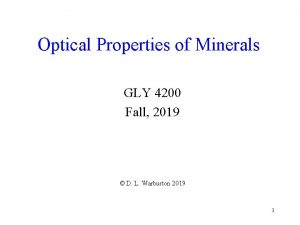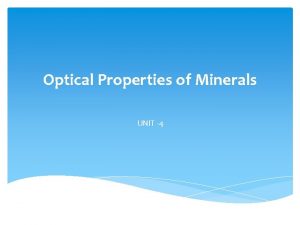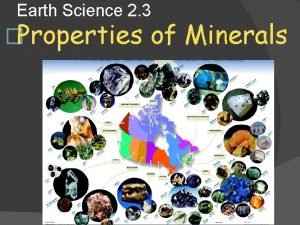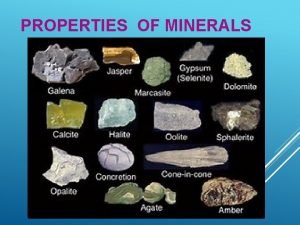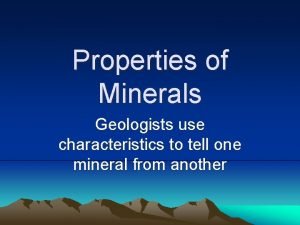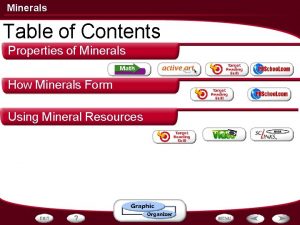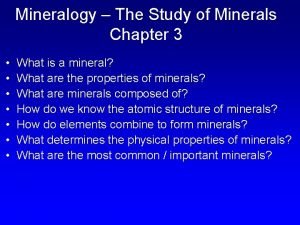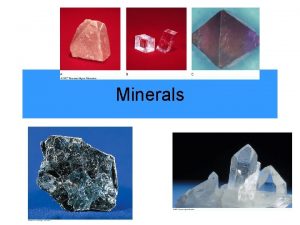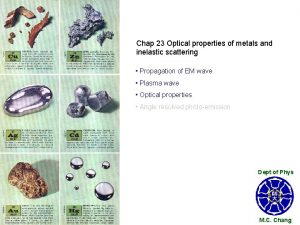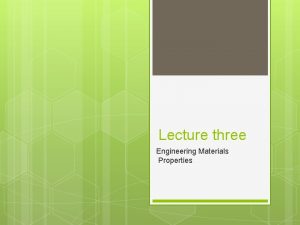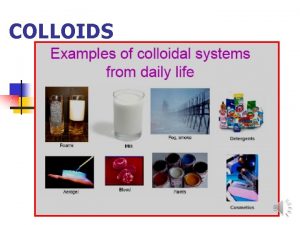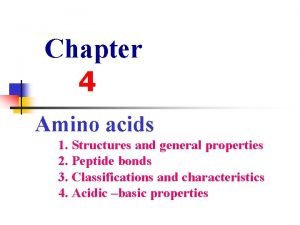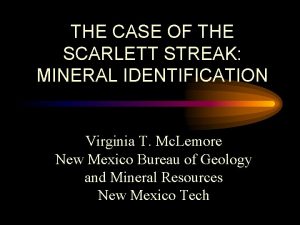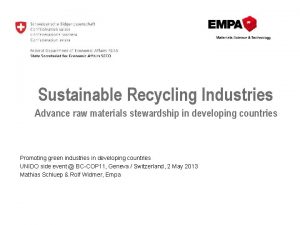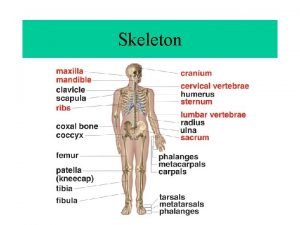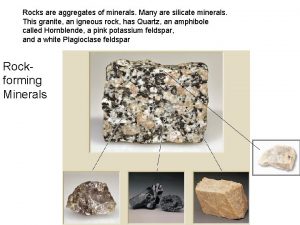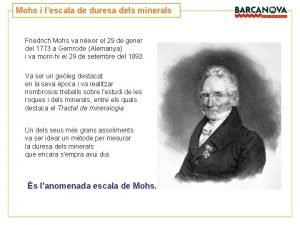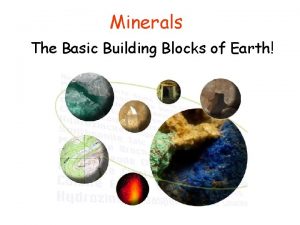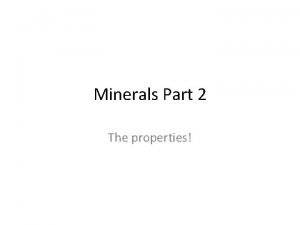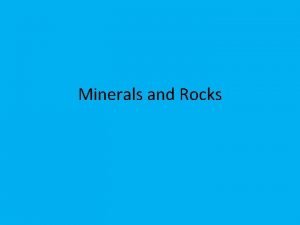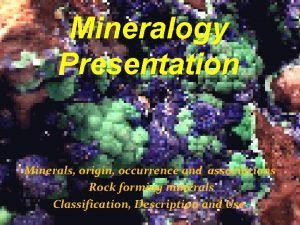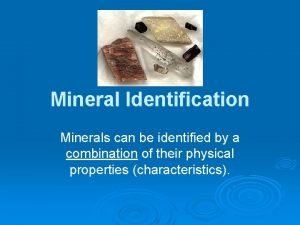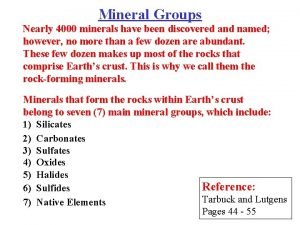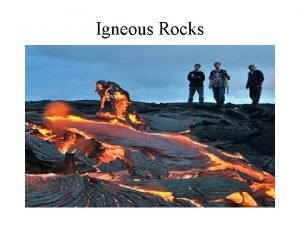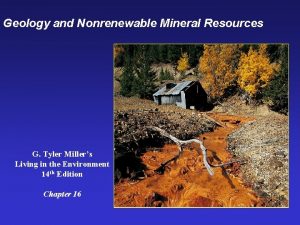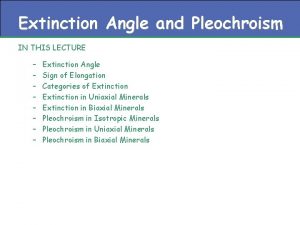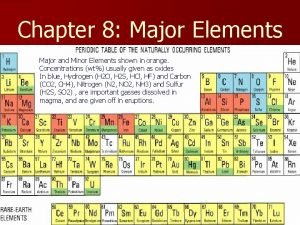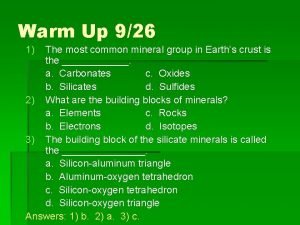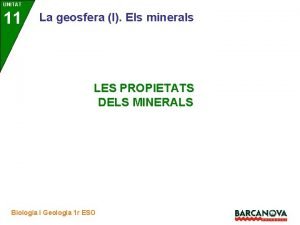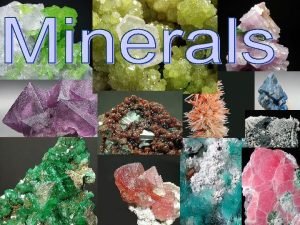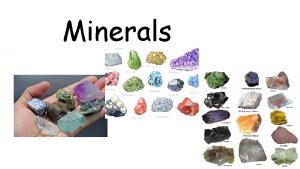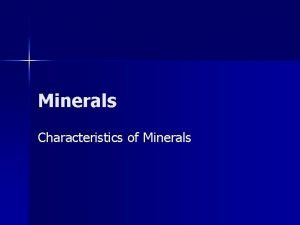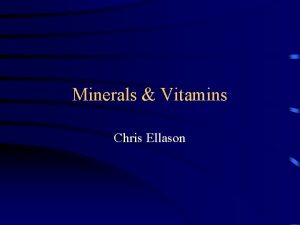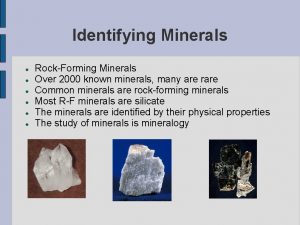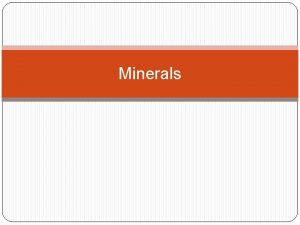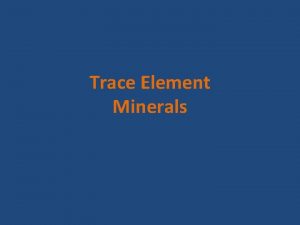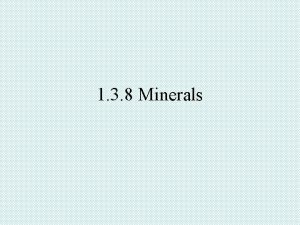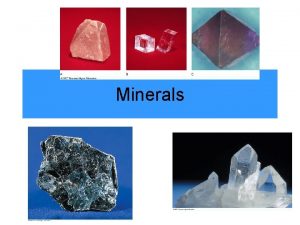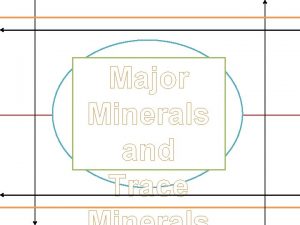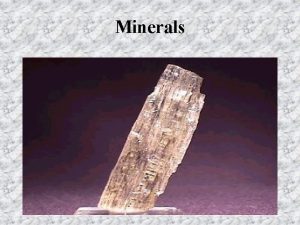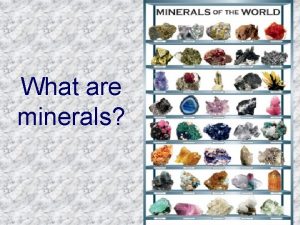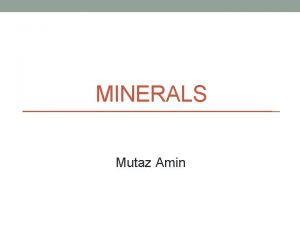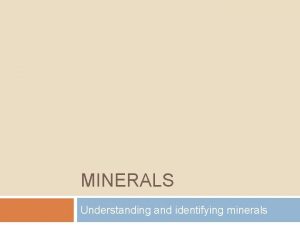Optical Properties of Minerals UNIT 4 Why study


















































- Slides: 50

Optical Properties of Minerals UNIT -4

Why study optical mineralogy 1. They assist in the identification of minerals – study their optical properties under the microscope. Minerals are inorganic chemical compounds having a certain lattice shape, size and symmetry, being a result of the geometrical arrangement of the constituents (chemical elements such as Si, Al, O, etc). Lattice (symmetry) + chemistry (nature of the chemical elements of the lattice) combine to make a unique mineral phase. The lattice (internal symmetry) of the mineral is reflected not only in the symmetry of the external crystal shape but also in the symmetry of optical properties of the mineral; therefore, determining the optical properties of an unknown phase assists in identifying the mineral phase; Mineral identification is needed in petrological studies, structural geology, mineral exploration etc…

Why study optical mineralogy 2. Microscopic study is the cheapest and fastest method for identifying minerals; however, there are limitations to the optical method, such as constraints of very small size (sub-microscopic) of minerals, or complex solid solutions, etc. 3. Microscopic study is required for Ø textural (natural arrangements of minerals) analysis Ø determining the rock type, crystallization sequence Ø deformation history or observing frozen-in reactions Ø constraining pressure-temperature history Ø noting weathering/alteration, etc.

Why study optical mineralogy In order to “see” the symmetry of the optical properties, and to determine the symmetry of a mineral, we need to understand: 1. What light is, and especially polarized light; 2. The difference between isotropic and anisotropic media (optical and other properties of minerals can be isotropic and anisotropic); 3. The tool of studying the optical properties of minerals (the petrographic microscope); 4. The use of specific charts of physical properties in order to identify unknown minerals; 5. A few specific optical properties which can help in quick identification of the common rock-forming minerals.

What is light Light is part of the electromagnetic spectrum, which ranges from radio waves to gamma rays. Electromagnetic radiation waves, as their names suggest are fluctuations of electric and magnetic fields, which can transport energy from one location to another. Visible light (also known as polychromatic light) is not different from the other parts of the electromagnetic spectrum with the exception that the human eye can detect visible waves.

Plane polarized light Natural light vibrates (oscillates) in all the directions perpendicular to the direction of propagation. Therefore we can say that there is infinity of planes of vibrations (all possible planes that intersects/contain the direction of propagation. Plane polarized light (PPL) has one single plane of vibration, in which the direction of vibration is always perpendicular to the direction of propagation

https: //youtu. be/W 6 v 7 Jd. K 4 sps

Plane polarized light We can use this plane of vibration as a geometrical reference for the optical properties of mineral. Keeping this plane fixed and rotating (changing the orientation of) the mineral, all of the mineral‟s optical properties can be measured or related to such a plane. Note that we can polarize light with a special designed material, called a nicol or polarizer. The name “nicol” comes from Nicol (Nicol‟ prism), a French scientist who first built a kind of prism of calcite, made of two halves of the same calcite crystal, adjusting the angles of the prism to a convenient value in order to eliminate all other planes of vibration but one. More commonly, these days, materials called polaroids are used for manufacturing polarisers (microscopic oriented crystals of iodoquinine sulphate embedded in a nytrocelulose polymer film).

ISOTROPIC AND ANISOTROPIC MATERIALS Isotropic means that any physical property of the material is the same at any point and in any direction through the material (it is independent of orientation). In mineral optics, the word “isotropic” refers to the optical properties of the mineral, which are the same and independent of the orientation (e. g. isotropic minerals). However, if a mineral is isotropic, it means that ALL of its physical properties are the same at any point. Minerals that are isotropic are the minerals with cubic symmetry (remember the symmetry of minerals crystallized in the cubic system have a=b=c and α=β=γ=90°), and non-crystalline materials such as glass, liquids, and gasses. Accordingly, an isotropic mineral has the same refractive index, the same absorption of light at any point and for any direction in the mineral.

ISOTROPIC AND ANISOTROPIC MATERIALS Anisotropic (in a general sense) means that the properties of the material are not the same at all points or directions, but may vary continuously with changing direction (orientation) of observation. Examples of anisotropic behaviour when changing orientation include different absorption of light, different refractive indexes, etc. All minerals, other than those belonging to the isometric system, are anisotropic. But some of them are “more anisotropic” than others, and the isotropy-anisotropy is related to the symmetry of crystals.

ISOTROPIC AND ANISOTROPIC MATERIALS Anisotropic crystals have variable refractive indices because light travelling through the crystals will do so at different speeds, depending on the direction of travel (the orientation of the crystal to the incident light). In optics the refractive index or index of refraction n of an optical medium is a dimensionless number that describes how light, or any other radiation, propagates through that medium. It is defined as n = c/v where c is the velocity of light in vacuum and v is the velocity of light in the medium. For example, the refractive index of water is 1. 33, meaning that light travels 1. 33 times faster in a vacuum than it does in water.

INTERACTION BETWEEN LIGHT AND MINERAL As light intersects an isotropic material (let‟s say glass or an isotropic mineral, such as garnet), the light suffers several optical phenomena, and is decomposed into several components. 1. Some fraction of the incident light is reflected by the surface of the mineral. 2. Another component of light entering the mineral is refracted. 3. a variable component of the light that enters the mineral is absorbed. 4. The remaining light (intensity), if any, succeeds in escaping from/through the mineral grain. This light is called transmitted light.

Thin sections for optical studies in transmitted light The light that remains after some fractions of it have been reflected or absorbed then exits the mineral is called transmitted light and the optical properties of the minerals are determined from this transmitted light. Minerals are the constituents of rocks, and usually a rock is composed of several mineral species. In order to study minerals we need to cut a slice of the rock, grind and polish a flat surface of it down to 30 microns (0. 03 mm) thick, and glue it, using a polymerized resin, onto a glass slide.

Thin sections for optical studies in transmitted light The refractive index of the resin must be known, in order to estimate correctly the (unknown) refractive indexes of minerals in thin sections (usually resin is 1. 542 if the resin is Canada Balsam. A cover slip is usually glued on top of the thin section (with the same resin) in order to protect the sample from „weathering‟ but also to have the same (known) refractive index below and above the sample.

Petrographic Microscope The optical methods normally used do not measure the intensity of the transmitted light, but instead use this light to provide information about the optical behaviour of minerals. The microscopes using transmitted light are called petrographic microscopes and they are used for studying the transparent minerals. The petrographic microscope is used to analyze the properties of the transparent minerals.

Petrographic Microscope https: //youtu. be/W 6 v 7 Jd. K 4 sps

Petrographic Microscopes The light source (1) is on the bottom of the microscope, under the blue filter. The blue filter is needed for absorbing the strong yellow-orange component of the light emitted by the electric bulb, in order to produce normal-looking white-coloured light. The 2 nd diaphragm is used for reducing the intensity of light (useful sometimes, for evaluating properties such as relief and chagrin). Similar effects can also be obtained by using the light intensity control dial (2). The white light coming up from the blue filter passes through a group of other diaphragms and apertures (13) also used for adjusting the light intensity and homogeneity. On its way up, the light passes through the polarizer (3), which is mounted so that the polarization plane is East-West in the image we see through the eye-piece, or ocular.

Petrographic Microscope Above the polarizer is mounted a mobile lens (convergent lens, 4). Above the convergent lens there is a rotating plate (11), which is the stage, and is graduated (360°) so that angular measurements can be made. In the middle of the plate there is a round hole where the polarized light goes through. Here we put the thin section (sample), so that the light from below can pass up through the sample. The polarized light will interact with the sample and the resulted light will continue upwards. To magnify the light transmitted through the sample, an objective (or a set of objectives) is normally used (5), having different powers of magnification (usually 2. 5 x, 6. 3 x, and 10 x, 20 x, 40 x or more). Up to 4 objectives are mounted on a typical nosepiece (6).

Petrographic Microscope Above the objective, the analyzer (10) is mounted. It also polarizes light, and is mounted so that its plane of polarization is perpendicular to the polarization plane of the polarizer (i. e. , the analyzer has the polarization plane mounted N-S ). The analyzer is mobile, so it can be pushed in (or pulled out) so that observations can be made either with or without the analyzer. • The final magnification of the image is provided by the ocular (9), which typically provides 10 x additional magnification.

Petrographic Microscope The total power of magnification of the microscope is equal to the power of magnification of the particular objective in use, multiplied by the power of magnification of the ocular; these values are written on both the objective and the ocular. For some specific determinations, the lamda plate (λ-plate = gypsum plate, or λ/4 -plate = muscovite plate; 7) and the Bertrand lens (8) can be used. The focused image through the microscope is achieved by using the focus knobs (12) (one large, for coarse focusing, and one smaller, for fine focus).

MINERAL IDENTIFICATION USING THE PETROGRAPHIC MICROSCOPE

Observations using plane polarized light (PPL) mode (Analyser is out) The observations typically made in PPL are 1. 2. 3. 4. 5. 6. 7. Transparency, Shape/habit/size, Colour, Pleochroism, Cleavage, Relief and Inclusions/alterations.

1) TRANSPARENCY A mineral is opaque if it appears totally black and stays black regardless of the rotation of the stage). The light cannot pass through the mineral, at all. Since the petrographic microscope is designed for studying the transparent minerals only, we cannot get diagnostic reflected light information here. However, we can observe shape, habit, and transparent inclusions, where present. Usually the opaque minerals are either sulphides (e. g. pyrite, chalcopyrite, etc. ), oxides (e. g. magnetite, hematite, or ilmenite), or graphite. If the mineral appears anything other than totally black (no matter what other colour is observed!) it means that the light passes through the mineral, so the mineral is transparent.

2) SHAPE, HABIT, SIZE Shape: Euhedral (or, if metamorphic, we call it idiomorphic), subhedral (hypidiomorphic) or anhedral (xenomorphic); Habit: isometric, prismatic, tabular, sheeted, etc. Size: estimated in mm, based on the field of view determined from the magnification by the objective and ocular lenses.

2) SHAPE, HABIT, SIZE Looking at the mineral boundaries, we can see the shape of the analyzed grain. In order to estimate the habit, several grains of the same mineral should be examined. If the grain boundaries are well developed with predictable interfacial angles, the grain is called euhedral (idiomorphic). If the grain shows irregular boundaries only, the grain is anhedral (xenomorphic). If the grain has both regular and irregular boundaries, it is subhedral (hypidiomorphic). The shape and size of the grains are related to the conditions of growth (crystallization). When crystals grow, depending on how favourable the conditions are, they may develop all of their crystal faces, or none of them at all (no preferred faces, so crystal grows as a shapeless blob = anhedral growth), or anything in between.

2) SHAPE, HABIT, SIZE CRYSTAL SHAPE

CRYSTAL HABIT

3. COLOR (ABSORPTION COLOR) The mineral is colorless if it appears white (we see the white light source!). If any other color is observed, the mineral is colored (and the color can be described). The observed color is the absorption color (absorption of a part of the white spectrum). The observed color should be described as color, nuances and intensity. For example: pale yellowish brown, bluish light grey, etc. If when rotating the stage, the color changes, then the mineral has pleochroism and the range of colors should be described, rather than a single color.

Color of minerals in thin section Biotite Crystals in PPL Hornblende crystals in PPL https: //youtu. be/F 9 MZKRly. DJM

4) PLEOCHROISM The term “pleochroism” comes from the Greek: pleos – many; chromos – colours. A mineral shows pleochroism when the absorption colour changes when the stage is rotated. It means that absorption of specific light wavelengths depends on the crystal orientation. This happens when the mineral is anisotropic. All anisotropic coloured minerals have pleochroism. However, the intensity of pleochroism (the changing of colour) can be different (from strong to weak). Common examples shown here include strong pleochroism of biotite and hornblende. Pleochroism is described as strong, moderate or weak, and the colour variation is described from the lightest to the darkest colour (e. g. pleochroism from light yellowish green to dark bluish green).

Hornblende Biotite Pleochroism in Biotite when the stage is rotated 90° Pleochroism in Hornblende when the stage is rotated 90°

5) CLEAVAGE Cleavages are planar surfaces of low cohesion produced by weaker atom bonds across them. They are visible when the cleavage is more or less vertical in the thin section. Cleavages seen in thin sections are linear expressions of the intersection of particular planes of crystal faces with the cut surface of the thin section. Some minerals may have three “good” cleavages (e. g. , calcite), some have a “perfect” cleavage (e. g. , micas). Some may have no cleavages at all (e. g. , olivine, which therefore has no “preferred” planes of splitting, and gets fractured, instead). The same mineral will always have the same cleavage.

5) CLEAVAGE Cleavage is said to be basal when it occurs perpendicular to the “c” axis of the mineral, and prismatic when it occurs parallel to the “c” axis. Multiple cleavages that produce geometric polygons are referred to using the name of the geometric polygon, such as octahedral cleavage in the mineral fluorite, cubic cleavage in the mineral halite, or rhombohedral cleavage in calcite. Cleavage in Calcite Prismatic Cleavage Basal Cleavage

5) CLEAVAGE The cleavage (quality and number of different cleavage planes) is diagnostic of some mineral species. From the shape of the observed grain in thin section and the quality and orientation of the cleavage(s), we can have an idea of the orientation of the section cut through the 3 -D grain morphology. In the figure we can see basal sections of amphibole (left) and pyroxene (right), displaying two characteristic sets of cleavages. Amphibole (2 cleavage at 120 and 60º) Pyroxene (2 cleavage at 90º)

5) CLEAVAGE The quality of the cleavage is estimated observing the density, continuity and width of the cleavage lines (which are always parallel lines) in thin section. The quality of cleavage is described as perfect, imperfect, good, distinct, indistinct, poor, or absent. The quality decreases from perfect (dense, almost continue and thin lines of cleavage) to weak cleavage (few, disperse segments of thicker lines) to absent (no cleavage, different curved and/or broken thick lines). For example: Perfect cleavage: micas, all phyllosilicates; Good cleavage: feldspars, pyroxenes, amphiboles; Weak cleavage: apatite, sodalite, olivine; Absent: quartz One good cleavage in Pyroxene (px) One good cleavage in feldspar (kfs and no cleavage in garnet)

6) RELIEF Refractive index (RI, n) is a measure of the speed of light in in vacuum to the speed of light in the given material. The higher the RI, the slower the light propagation in the mineral. “Relief” refers to the relative difference in RI between neighboring crystals. Although relief is most useful as a comparative term (some minerals show higher relief than others), the relief can be positive or negative compared to a reference material of fixed and known RI. This reference standard is the resin, which has a known refractive index (n = 1. 54 -1. 55). All minerals with relief higher than the resin have positive relief and all minerals with lower relief than the resin, have negative relief. Left: low relief of quartz (it can hardly be distinguished from the resin because the refractive indexes of quartz and resin are very similar). Right: High relief of garnet comparing to the resin. It boundary appears extremely distinct and thick

7) INCLUSIONS, ALTERATIONS Minerals can have inclusions, which can be solid (other finer-grained minerals) or fluid (liquid and/or gas) inclusions. Choose a higher magnification objective and describe the inclusions, if present (transparent or opaque, colorless or colored, relief, etc. ). If altered, other minerals (alteration minerals) can appear at the margin of the analyzed mineral, or along its cleavages or cracks. Describe the alteration mineral separately using a higher magnification objective. Alteration Inclusion

Observations using crossed polarized light (XPL) mode (Analyser is in) The observations typically made in crossed niclos (XPL) are 1. Isotropy/Anisotropy, 2. Extinction angle, 3. Birefringence color, 4. Twinning/Zoning, 5. Specific textures (Exsolution)

1) ISOTROPY/ANISOTROPY A transparent isotropic mineral is dark gray or black in crossed nicols, and the colour doesn’t change during rotation of the stage. NOTE: do not confuse an isotropic mineral (or an isotropic section through an anisotropic mineral) with an opaque mineral! An opaque mineral is totally black whether the analyser is in OR out, while the transparent, isotropic mineral is not opaque! If the mineral is anisotropic, it shows 4 positions of extinction and 4 positions of maximum interference when rotating the stage.

2) EXTINCTION ANGLE On rotation of the microscope stage minerals that are aniositropic will become dark in one particular orientation, such minerals are said to be in extinction. Extinction angles can only be measured relative to planar crystal boundaries or cleavage planes. The extinction angle is the measure between the cleavage direction or habit of a mineral and the extinction. To find this, simply line up the cleavage lines/long direction with one of the crosshairs in the microscope, and turn the mineral until the extinction occurs. The number of degrees the stage was rotated is the extinction angle, between 0 -89 degrees. The extinction can be parallel, symmetric or oblique. Extinction direction provides important information on the crystal system of minerals, since orthorhombic, tetragonal and hexagonal crystals have an extinction angle of zero, that is they have straight extinction, whilst monoclinic and triclinic minerals have a finite extinction angle, that is they have inclined extinction. Some minerals have characteristic ranges of extinction angles. Clinopyroxene

Not Extinct Quartz crystals in plane polarized light Extinct Same quartz crystals with analyzer inserted (cross polarizers aka crossed nicols)

One grain Individual crystals Feldspar https: //youtu. be/JM 0 fq. EEc. MMQ partially extinct,

Type of Extinction Parallel Extinction: The mineral grain is extinct when the cleavage or length is aligned with one of the crosshairs. The extinction angle (EA) = 0° Example Orthopyroxene, Biotite Inclined Extinction: The mineral is extinct when the cleavage is at an angle to the crosshairs. EA > 0° Example: Clinopyroxene, Hornblende Symmetrical Extinction: The mineral grain displays two cleavages or two distinct crystal faces. It is possible to measure two extinction angles between each cleavage or face and the vibration directions. If the two angles are equal then Symmetrical extinction exists. Example: Amphibole, Calcite No Cleavage: Minerals which are not elongated or do not exhibit a prominent cleavage will still go extinct every 90° of rotation, but there is no cleavage or elongation direction from which to measure the extinction angle. Example : Quartz, Olivine

2) EXTINCTION ANGLE Determination of the extinction angle Move the stage so that the crystallographic reference (e. g. the crystal face, cleavage, etc. ) is aligned N-S. Record the position of the stage. Then rotate the stage (in the sense where the crystal arrives faster in the extinction position) until the crystal has its maximum extinction (remember that there are four positions of extinction at each 90°). In this second position, when the crystal is extinct, record the stage position again. The difference between the two readings is the extinction angle.

3) BIREFRINGENCE COLOR Birefringence is a value that can be used to determine interference colour of a mineral section in cross polarised light. Interference colour is the colour exhibited by a section of an anisotropic mineral under cross polarised light. The birefringence is the difference between the largest and smallest refractive index of a mineral section. The birefringence of isotropic minerals is zero in any direction. The birefringence of uniaxial and biaxial minerals (aniosotropic minerals) is only zero where the light ray is incident parallel to the optic axes. Muscovite showing 2 nd and 3 rd order interference colors Common minerals with low order interference colours: Quartz, Plagioclase, K-Feldspar, Chlorite Common minerals with moderate order interference colours: Amphiboles, Pyroxenes Common minerals with moderate-high order interference colours: Muscovite, Biotite, Olivine Common minerals with very high order interference colours: Calcite

3) BIREFRINGENCE COLOR The interference color is produced by interference between the two rays produced as light passes through an anisotropic mineral, the fast ray and the slow ray. Interference color can be interpreted using colour charts. A relationship between interference color and retardation can be graphically illustrated in the classical Michel-Levy interference color chart. If the thickness of a section is known the birefringence can be determined from the interference color. Maximum birefringence can be diagnostic of a mineral when used with other properties. If the thin section contains a known mineral, with a restricted range of birefringence, then the interference colour can be used to determine thickness of the section. Standard thin sections are 30 microns thick. Thin sections thicker than 30 microns will produce higher order interference colours.

4) TWINNING/ZONING Twinning is recognized by adjacent portions of a single crystal having different extinction positions. Twinning is most easily observed with crossed polars. A twin is a symmetrical growth of two or more crystals of the same mineral. The common plane of the twinned crystals (which is called the twinning plane) is a symmetry plane, seen in thin section as a straight line separating two identical crystals which have a symmetrical optical orientation to the twinning plane. This is observable by rotating the stage when crystal (1) is in extinction, its twin crystal (2) shows interference colours. Continuing the rotation of the stage, crystal 1 shows interference colours and crystal (2) will enter into a position of extinction.

4) TWINNING/ZONING If more than two crystals are twinned, having parallel twinning planes, the twinning is called polysynthetic (sometimes also called lamellar twinning). Plagioclase commonly shows lamellar twinning. Such twinning is one of the most diagnostic features of plagioclase. Twinning may take a variety of different forms and is particularly common and distinctive in the feldspars (plagioclase and K-Feldspar). Several laws of twinning are possible and they can be recognized using the microscope (e. g. Polysynthetic twins after the “albite” and “pericline” laws in plagioclase, Carlsbad twins in plagioclase or orthoclase, cyclic twins in leucite, etc. ). Carlsbad twinning, in Polysynthetic albitetype twins in plagioclase Tartan twinning, microcline – K-feldspar Orthoclase

4) TWINNING/ZONING Chemical zoning is a feature of a crystal where different growth zones of the crystal have different compositions. Chemical zones trace the outline of the crystal during its growth. Chemical zoning occurs only in minerals that belong to solid solution series that crystallize with different compositions at different temperatures (and/or pressures Several different types of chemical zoning are identified on the basis of the changes in composition that occur from one growth zone to another through the crystal. Euhedral plagioclase crystal with normal zoning These include: (1) normal zoning, (2) reverse zoning, (3) oscillatory zoning, (4) sector zoning, (5) convolute zoning, (6) continuous zoning, and (7) discontinuous zoning. Crystals that have chemical zoning exhibit growth zones with different interference colours in thin section, they may also have different colours in plane polarized light. Crystals with chemical zoning are described as zoned crystals. Euhedral plagioclase phenocryst with oscillatory zoning

5) SPECIFIC TEXTURES (EXSOLUTION) At high temperature, some minerals may incorporate a range of different elements in their crystal lattice. However, on cooling these lattices may become more stable if a physical separation into two mineral phases occurs. Thus some minerals tend to like to be homogeneous mixtures at high temperatures but will separate at lower temperature if the rate at which they cool down is sufficiently slow to allow the separation to be effective. Pigeonite exolution lamellae in Augite In such circumstances, the host mineral may exsolve small crystals of the other mineral and a distinctive texture will result. Such exsolution textures are most readily observed in cross polars as host and exsolved minerals often have rather similar optical properties and so may have similar relief. Common minerals that show exsolution textures: Feldspars (plagioclase and K-feldspar), Pyroxene (clinopyroxene and orthopyroxene). A twinned orthoclase crystal with cryptoperthite (exsolution of albite)
 Optical properties of minerals
Optical properties of minerals Amphibole thin section ppl
Amphibole thin section ppl Andreas carlsson bye bye bye
Andreas carlsson bye bye bye Color properties of minerals
Color properties of minerals Rock cleavage
Rock cleavage Properties of minerals
Properties of minerals Cleavage minerals
Cleavage minerals How are minerals formed
How are minerals formed Physical properties of minerals graphic organizer answer
Physical properties of minerals graphic organizer answer Mohs scale of hardness
Mohs scale of hardness Minerals vs elements
Minerals vs elements Optical properties of metals and nonmetals
Optical properties of metals and nonmetals Optical properties of engineering materials
Optical properties of engineering materials Discuss the optical and electrical properties of colloids
Discuss the optical and electrical properties of colloids Properties of amino acids
Properties of amino acids Inherent optical properties
Inherent optical properties Dont ask why why why
Dont ask why why why Unit 10, unit 10 review tests, unit 10 general test
Unit 10, unit 10 review tests, unit 10 general test Extensive vs intensive properties
Extensive vs intensive properties Physical properties of ice cube
Physical properties of ice cube The study of composition structure and properties
The study of composition structure and properties Physical properties of speech sounds
Physical properties of speech sounds Thermosoftening plastics examples
Thermosoftening plastics examples Why are colligative properties important
Why are colligative properties important Emergent properties of multicellular organisms
Emergent properties of multicellular organisms Streak of minerals
Streak of minerals Conflict minerals
Conflict minerals Storage of minerals
Storage of minerals Primary vs secondary minerals
Primary vs secondary minerals Quartzite rock cycle
Quartzite rock cycle Rocks are aggregates of minerals
Rocks are aggregates of minerals Song about igneous rocks
Song about igneous rocks Why is bowen's reaction series important
Why is bowen's reaction series important Mohs
Mohs The building block of the silicate minerals is _____.
The building block of the silicate minerals is _____. Fracture minerals
Fracture minerals Characteristics of a mineral
Characteristics of a mineral Prepare chart for vitamins and minerals
Prepare chart for vitamins and minerals Define luster in minerals
Define luster in minerals Nearly 4000 minerals have been named
Nearly 4000 minerals have been named Pumice rock type
Pumice rock type Economic minerals
Economic minerals Carbohydrate vitamin
Carbohydrate vitamin Types of extinction in optical mineralogy
Types of extinction in optical mineralogy Chapter 8 vitamins and minerals
Chapter 8 vitamins and minerals Major elements
Major elements Difference between rocks and minerals
Difference between rocks and minerals Most abundant minerals in earth's crust
Most abundant minerals in earth's crust Propietats dels minerals
Propietats dels minerals Minerals in the soil
Minerals in the soil Characteristics of minerals
Characteristics of minerals
